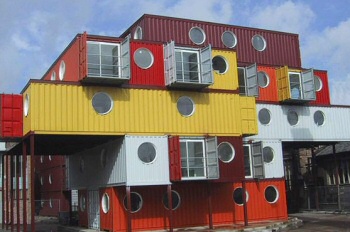Container City
Architect
Nick Lacey is an imaginative architect who has won three first place awards for architectural competitions. In 1971, Nick Lacey followed in his father's footsteps and opened his own architect office.
Design and Construction
 The proposal was to build housing using metal containers that could be quickly and economically built. ContainerSpace built Container City, which is situated in South London's Dockland area, using the method that was designed and created by Nicholas Lacey and his partners. The plans called for self-contained spaces to be built in two stages. In the first Container City, containers were stacked providing 12 studios and in the second Container City an additional 30 containers were used. The following result is two groups of containers that are serviced by connecting bridges.
The proposal was to build housing using metal containers that could be quickly and economically built. ContainerSpace built Container City, which is situated in South London's Dockland area, using the method that was designed and created by Nicholas Lacey and his partners. The plans called for self-contained spaces to be built in two stages. In the first Container City, containers were stacked providing 12 studios and in the second Container City an additional 30 containers were used. The following result is two groups of containers that are serviced by connecting bridges.
The basic container was modified to make it suitable for habitable space. Round pivoting windows and a sliding glass door replace the metal doors at the end of the containers. The inside of the containers are sprayed with insulation and the walls are finished in plasterboard. A single container may suffice for a miniature office or studio. An important problem that was involved in the design was how to unite the container interiors. The problem was solved by removing the side walls and supporting the edges with steel. Several containers used together results in space that varies in size from 200 to 550 square feet.
Container City in London is an example of a large scale housing development made up of shipping containers that have been recycled. The development is composed of environmentally friendly lofts and studios stacked on top of one another to create the five story building. Nick Lacey and Partners created a flexible design that relies on pieces rather than units to create very liveable and adaptable spaces.
The system used for the Container City project, has been used in other diverse projects, as well. Using shipping containers as architecture is just one way to look at different objects and find new and innovative uses for them. Shipping containers make an ideal prefab material, due to their modular shape and adaptability, not to mention that they can be found in surplus.
History
The site of Container City is known as Trinity Wharf, which is a peninsula. From 1809 to 1988 the site was owned by Trinity House and the vicinity was used for manufacturing. The property is now owned by Docklands Development Company.
The site then became available for redevelopment following the decline the city's manufacturing activities and the relocation of the shipping industry. The remaining industrial sites were landmarks and a creative use needed to be found for the beautiful old warehouses and buildings scattered throughout the peninsula. In 1997, Urban Space Management, which is an organization with 30 in urban regeneration initiatives, was chosen to develop the site as a cultural centre. The plans called for the warehouses to be converted to studios and workshops.
Work started in 1998 and today it is a thriving place for creative people. Currently, there is a wide range of activities on the site, which include events, exhibitions, workshops, and studios. There is a mixture of new and carefully preserved buildings with plenty of open space. Recent developments include a pier and large workshop schemes made from recycled shipping containers. Urban Space Management is currently working to bring a new bridge over the Lea River to link Orchard Place to Canning Town.
The closest stations to Container City are Canning Town, Blackwall, East India and Canary Wharf.
